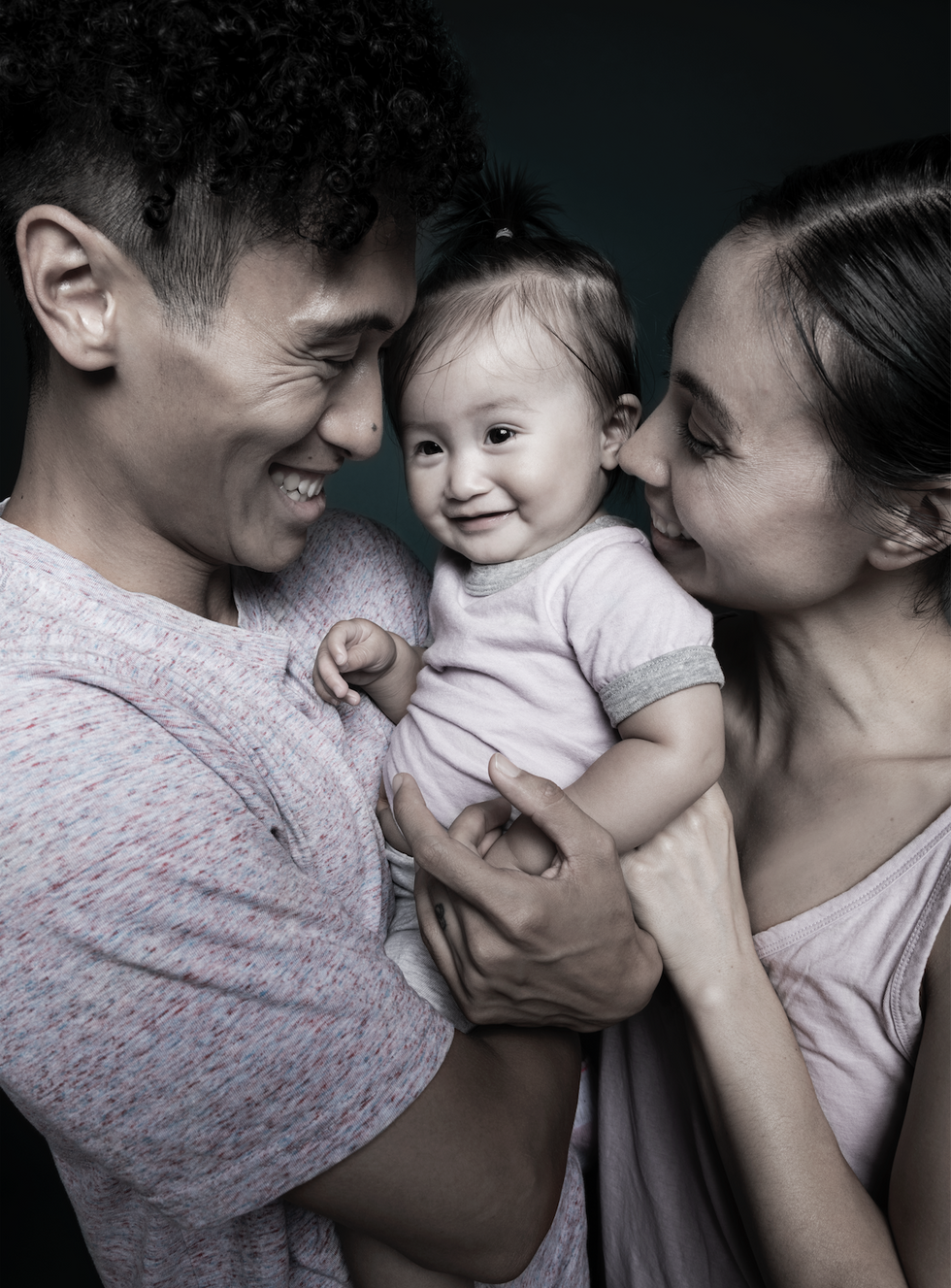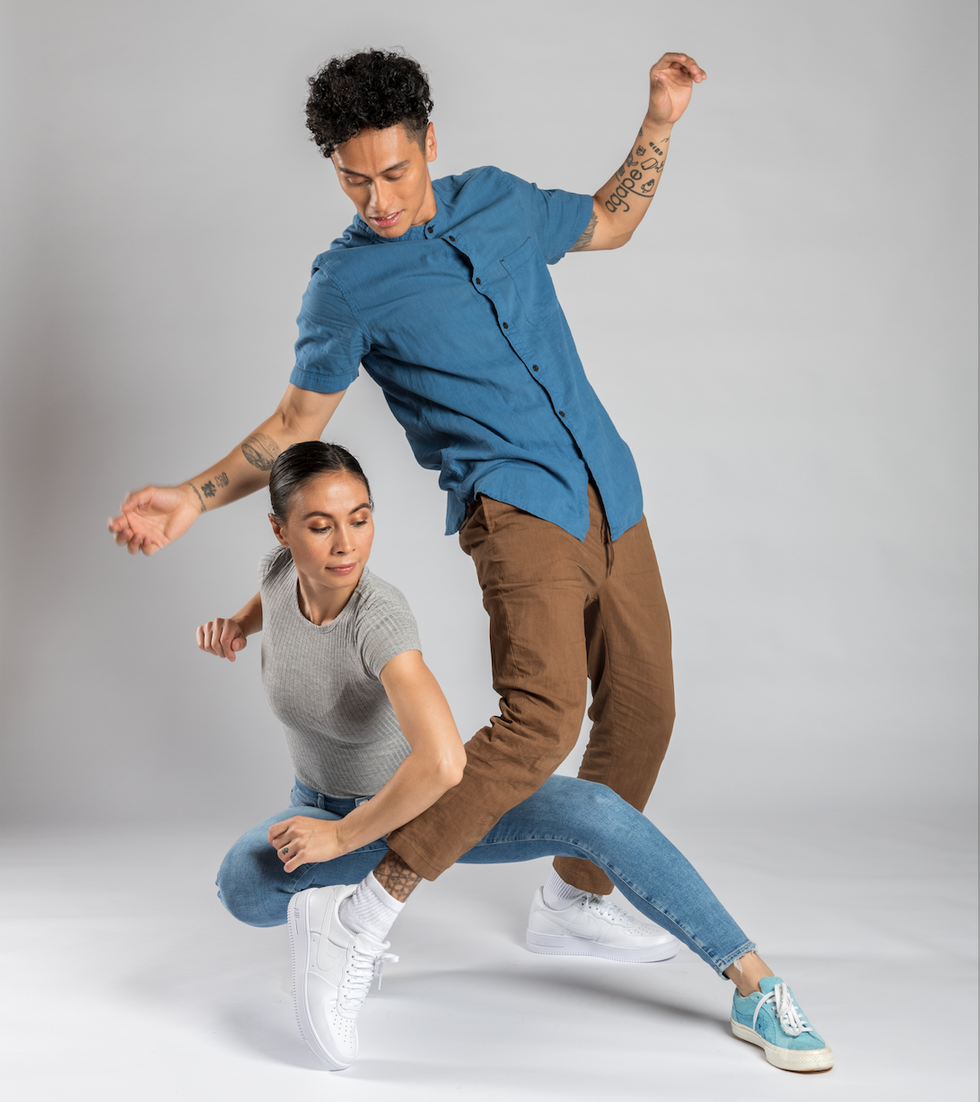The Storytellers: Keone and Mari Madrid Capture What It Means to Be Human
Keone and Mari Madrid sit around their kitchen table—à la quarantine—their fingertips brushing the surface, tapping to hidden dynamics of a Ben Sollee track as they weave in and out of one another’s arms. The video, titled “Built for This,” is a danced message of gratitude for health-care workers. Later in the film, out on their balcony, their arms subtly fluctuate from positions of prayer to praise, depicting the evening cheers for frontline heroes. It’s unpretentious, human movement that has become their signature style.
Had a pandemic not shuttered the dance industry, they’d be unlikely to be in their San Diego home. COVID-19 way-laid both the Chicago run of Once Upon a One More Time (their new Britney Spears musical coming to Broadway) and the New York City performances of their first full-length production, Beyond Babel. It also took a toll on their own health—both the Madrids and their now 1-year-old daughter Numah contracted the illness. All have since, fortunately, recovered.

Despite everything, the powerhouse couple still has much in the works, including choreographing both The Karate Kid and Once Upon a One More Time for Broadway, expanding their San Diego dance studio and working on a top-secret Disney project. Their wholesome brand of hip hop continues to connect with audiences—perhaps especially during this tumultuous time. As the country carries on the fight against racism, sickness, intolerance and abuse, they find inventive ways to use their sincere movement to encourage the best of their audience.
“It’s their storytelling that is so impactful,” says one of their dancers, Fabian Tucker. “It reaches people. Their choreography goes beyond this moment in time. It’s timeless.”
Keone was 15 when he attended his first formal dance class. A woman had invited his friend to take hip hop, and Keone joined as wingman. “It was a game changer,” he says. Soon Keone was bouncing from high school football and basketball practices to the dance studio—often clad in sports gear. He joined a junior competitive team, Future Shock San Diego (the apprentice crew of Culture Shock San Diego), led by some of the area’s top talent. When he became director of FSSD, one of his students began uploading clips from class to YouTube, landing Keone his first international job in Norway.
Mari, meanwhile, started out as a gymnast in Boulder, Colorado. When she decided to quit, her mother sent her to a weeklong hip-hop intensive instead. She fell in love with it and later joined the competitive dance team while at California College of the Arts. One of her friends there filmed a class she taught and put it on YouTube, opening up a variety of international teaching opportunities, including a fateful one in Norway.
Both dancers were offered the Norway gig at the same time, with the director planning to give the opportunity to whoever responded first. True to their natures, Mari took the day to think things through, while Keone said yes immediately. When Mari found out Keone had taken the job, she bristled. “I was like, ‘Who even is Keone?’ ” she remembers. “My roommate at the time, Kyle Hanagami, had to show me a video of him.”
Keone felt bad, so when he and Mari later taught at the same workshop in the U.S., he decided to make amends. “I wanted to introduce myself and be nice,” he says. “But she was pretty cold, and I thought, Well, there goes that. Then she took my class.” Keone reached out to Mari through MySpace and asked if she would choreograph for his FSSD team. “It took four days of spending time together to become a couple and say ‘I love you,’ ” Keone says. “We just knew.”
However, it wasn’t immediately obvious to either that they should work together. In fact, they avoided it for the first six months. “We were in the honeymoon phase and didn’t want to introduce something that could potentially make us fight,” Mari says.
Eventually, an opportunity came up to create a competition set for Choreo Cookies—the dominant, San Diego–based competition team the Madrids would dance with for eight years. “It worked,” Keone says. Over time the two started exploring partner-work together, and established an identifiable style that consists of immensely intricate movement weaving in and out of their two bodies in mesmerizing ways.
Mari admits they used to fight often when creating new work. “We still fight here or there,” she says, “but we have become more comfortable disagreeing with each other. We know how to do it respectfully. That is, we disagree efficiently by listening to each other.”
Their approach has changed over time, too. They used to start by trying to come up with specific movements. “Now we turn on music and just bounce off each other,” Keone says. “We say, ‘Oh, I like that’ or ‘Let’s try something else.’ We have a dance vocabulary built between us that we trust to take over.”

That vocabulary has opened a world of opportunities: They’ve choreographed music videos for Justin Bieber, BTS, Billie Eilish and Ed Sheeran; pieces for “World of Dance,” “So You Think You Can Dance” and “Dancing with the Stars.” Altogether, their videos on YouTube have amassed more than 2 billion views and counting.
With their dancers, Keone and Mari apply a leadership style that’s based in community gathering. Tucker recalls assisting the pair when they auditioned dancers for Beyond Babel. “They talked to everyone about not stressing out, being supportive and approaching it like class,” he says. “Everyone is always going to be their best in that environment. After the audition, a bunch of people came up to me and said it was one of the funnest experiences they have ever had.”
Although Mari was still dancing onstage at seven months pregnant at Coachella with Billie Eilish in 2019, the couple’s path has changed since Numah was born. A week before Mari went into labor, they got a call telling them they’d been promoted from choreographers to directors for their first Broadway production, Once Upon a One More Time. The show would keep them in one place for an extended period, something their usual commercial jobs didn’t allow.
Even the offer to choreograph in the first place had surprised them. “I thought, Don’t you want Brian Friedman?” Mari says. But once they read the script and saw the heart of the story (how a group of fairy-tale princesses discover feminism), they were hooked.
Movement that tells a story has always been at the center of the Madrids’ work. They’d already been doing short-form storytelling for years. Beyond Babel, which the pair co-created and starred in, proved they could tackle long-form, as well. The contemporary retelling of Romeo and Juliet comments on today’s social issues—in particular the proposed border wall.
The show’s New York City run had just been extended and the Madrids were in rehearsals for Once Upon a One More Time when the pandemic halted everything. “Things were moving so fast and then just stopped,” Mari says. “The first couple of weeks were scary while we dealt with the illness. The silver lining is we have gotten to be with our daughter. She has started crawling, and got some teeth. We’ve had so much time that we wouldn’t have had otherwise.”
After making a full recovery from COVID-19, an opportunity to expand their San Diego studio, Building Block Dance, arose and quickly sucked up any free time. The vision for the school is holistic dance training: Beyond teaching choreography, they offer a total mind, body and spirit approach to dance, including meditation, nutrition, mental health, stretching, exercise and fine-tuning creative skills.
The new space doubles as a film studio with white walls and professional lighting so the pair can offer virtual classes similar to MasterClass, the popular online teaching tool. “We had talked about creating an online platform before COVID-19, but it was always on the back burner until now,” Mari says. “Nothing will ever take the place of in-person training, but this is an opportunity to share our work with people who we wouldn’t have been able to work with previously.”
Beyond the expansion of their school, Keone and Mari have also been working on a still-to-be-announced short film for Disney that celebrates dance as a storytelling device. “I wanted a film where the entire world was one of dance—where dance was not just something you did, but it was how you moved,” says director Zach Parrish.
From the beginning, he knew he wanted Keone and Mari to choreograph. “They have an incredible ability to communicate both emotion and story very clearly through movement. It feels like a superhuman exaggeration of real life.”
More than just their work, Parrish was drawn to Keone and Mari because of who they are as individuals. “The stories they tell, the way they look at the work inclusively, the way they treat those they work with, their daughter, and each other shows what genuinely good people they are,” he says.
Beginning in May, shortly after the murder of George Floyd, Keone and Mari took inventory of their own lives and the ways they might unknowingly contribute to systemic racism. They made a public statement that they would no longer call their genre of dance “urban,” acknowledging the harmful racial implications of the term.
The change highlighted an interesting challenge. “Going from hip hop, to being told I’m not hip hop, to ‘hip hop with air quotes and an explanation,’ to ‘urban dance,’ to discarding a word that clearly doesn’t work, and back to an orphan of genre has been an interesting journey, but a beautiful learning experience nonetheless,” Keone captioned an Instagram post.
Just weeks later, the two released a video meant to champion the Black Lives Matter movement. When some viewers criticized the work for perceived saviorism, the two announced a plan to amplify Black voices in and out of the dance community, starting with Instagram takeovers.
Despite everything, Mari believes this time of turmoil will ultimately bring dancers together. “The wonderful thing about dance is that it is an outlet,” she says. “All you need is your body and maybe some music. We will all come back with a greater desire to lift others up through dance.”



